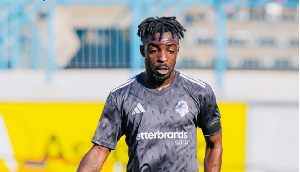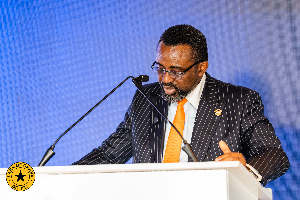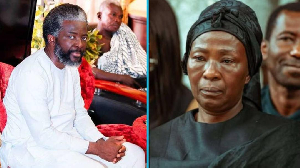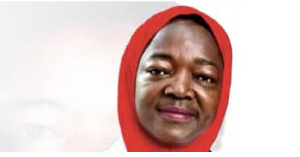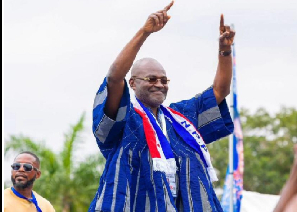By Kwame Okoampa-Ahoofe, Jr., Ph.D.
In 1902, when the birth of Africa's greatest freedom fighter in the twentieth century was sixteen years into the future, the legendary African polyglot and polymath scholar, Dr. W. E. B. DuBois, wrote and published a classic and prophetic article which clearly anticipated the birth and nonesuch emergence and ascendancy of Nelson Madiba Rolihlahla Dalibhunga Mandela. Titled "Of the Training of Black Men, this was what Dr. DuBois had to say:
I insist that the question of the future is how best to keep
these millions [9 million Negroes] from brooding over the
past and the difficulties of the present, so that all their
energies may be bent toward a cheerful striving and co-
operation with their white neighbors [and former oppressors
and enslavers] toward a larger, juster, and fuller future
(See Jabari Asim's What Obama Means. New York: William
Morrow, 2009: 9; initial brackets are Jabari Asim's)
In quite a strikingly similar sense, the first African-American doctoral graduate of Harvard University could equally have been anticipating the historic emergence of the foremost American moral revolutionary of the twentieth century, Dr. Martin Luther King, Jr., who was born exactly a decade after the birth of Nelson Mandela but, paradoxically, slightly preceded the latter in his emergence and meteoric rise to the pinnacle of the multicultural and multiracial battlefront. In the global pantheon of global African liberators, it is Martin Luther King, Jr., who comes closest to Mandela in both stature and ideological orientation.
Both men, of course, claimed their strategic and philosophical orientation to have been heavily indebted to Mahatma Gandhi, the legendary revolutionary sage of India's anti-colonial struggle, and sometime resident legal practitioner in South Africa, where he is widely known to have first attempted to put into practice, his now globally acclaimed principles of Satyagraha, or non-violent resistance to colonial oppression.
Anyway, from City Hall, the next stop on the Mandela-Mobile express route was the Ticker-Tape Parade in the Canyon-of-Heroes. The Ticker-Tape Parade is a time-honored New York City tradition of parading our heroes, often war veterans and sports and athletics champions, among other equally high achievers in diverse professional disciplines, through what is called the Canyon-of-Heroes. The Canyon-of-Heroes is no Canyon at all, in the strictly geographical sense of the term; it is just an alleyway created by some of the city's skyscrapers. Well, then again, it somewhat looks like a gorge or a tunnel. And so in that sense, I guess, it could aptly be called a canyon.
You haven't been welcomed well enough until you have been paraded through the Canyon-of-Heroes. At City Hall, the grand-statesman of South Africa had received the symbolic key to the city; now it was time to festively induct him into New York City's "Honorary Citizenship." This portion of the festivities reminded me of how I got to be warmly admitted into honrorary membership of the City College of New York Chapter of the African National Congress (ANC of CCNY).
As I recounted at the beginning of this serialized grand narrative in memory of the legendary leader of Umkhonto We Sizwe (Spear-of-the-Nation), the largely guerilla military wing of the apartheid era's African National Congress, the hanging of the invidiously racialized political map of continental Africa in the classroom by Professor Michael Keating, my City College print-journalism lecturer, had painfully brought home to me the stark fact that, in the indelible words of Stephen Bantu Biko, we, Black Africans, as a people,we are defeated and humiliated people wherever we happened to be. In sum, I had become radicalized as never before in my life.
In Ghana, of course, I had known about the exceptionally and inordinately protracted anti-apartheid liberation struggle. We had even periodically marked the United Nations-endorsed birthday anniversary of Nelson Mandela, the standout symbol of ANC's liberation struggle. I had even written a poem or two, as well as improvised songs in celebration of the steely resolve of Nelson and Winnie Mandela never to back down or compromise their moral and political values until Black-majority rule had been democratically established on the southern tip of the proverbial primeval continent.
Nonetheless, in both practical and ideological sense, it was my immigration into the United States, and the privilege of my coming into close contact with Black South Africans, that had brought the full gravity of the sticky question of apartheid traumatically home to me. Then around about 1987, I had made the solemn decision of forging a common cause with my City College South African classmates and associates.
This is how it all started: I had been going through a list of officially registered student clubs and organizations on campus, when I spotted the name of the African National Congress. Now, this is my choice of a club! I told myself rather loudly. I also noticed that Tuesdays and Thursdays, early in the afternoon, perhaps between 12:30 and 1:45, if memory serves me accurately, was the club-activities hour. I had already attended the meetings of several other clubs, including the Nigerian Students' Organization (NSO) and even registered as a dues-paying member; I had also had the ironic occasion of introducing my Nigerian buddy, Joshua Satty Oyekake into the NSO as a new member. Josh had not even known that there existed on campus a Nigerian students' club, although he had preceded me to City College by a year or two. And when I met him, through a philosophy class that we took together, Josh was already a graduate student in the School of Engineering.
At the time, as I vividly recall, there was no Ghanaian Students' Assocation (GSA) on campus. That would come a bit later, and I would sign up membership with the GSA but refuse to quit the NSO, as one of my Ghanaian club member acquaintances had politely, albeit plaintively, advised, because I firmly believed that the Nigerian group was far better organized and more dynamic and focused than its fledgling Ghanaian counterpart. And, of course, this was also at the peak of the pan-Africanist phase of my psychological orientation and development. Then, also, the NSO members seemed to be more politically committed. It was quite common, for example, to meet a remarkable number of Nigerians at such momentous events as the "Free Mandela Rally" at Manhattan's Columbus Circle, in the summer of 1988, but not a single member of the Ghanaian Students' Association would be present, except for yours truly. And I found that to be rather disturbing and embarrassing.
The Kenyans were not that many on campus, but they were fast beginning to make their presence felt, and you could also count on them showing up in remarkable numbers at these rallies. And they were also, after the South Africans, perhaps the most politically conscious African group on the CCNY campus.
Anyway, the Ticker-Tape Parade entailed marching, beeline-fashion, in pairs, through this gorge-like alleyway near the southern tip of Manhattan's business district, and having streamers, confettis and endless rolls of computer printouts tumble down by humans hunched over open windows ten to twenty floors up. At certain points on the route, on this occasion, it clearly looked as if some of the people dropping the papers really intended to break a neck or two. For once or twice, a heavy ream of printouts missed my pate by an inch or two. A handful of celebrants marching close by were, however, not so lucky.
_____________________________________________________________
*Kwame Okoampa-Ahoofe, Jr., Ph.D.
Department of English
Nassau Community College of SUNY
Garden City, New York
Dec. 24, 2013
E-mail: okoampaahoofe@optimum.net
###
Opinions of Tuesday, 24 December 2013
Columnist: Okoampa-Ahoofe, Kwame




